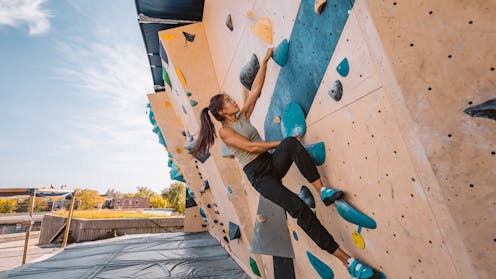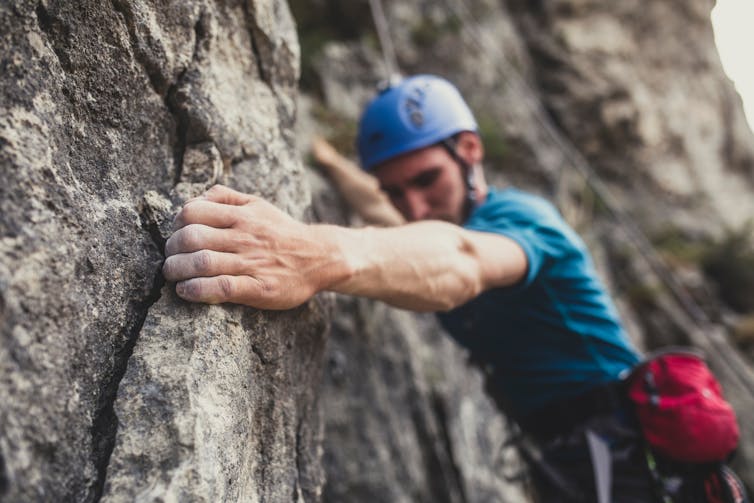Source: ForeignAffairs4
Source: The Conversation – UK – By Dan Baumgardt, Senior Lecturer, School of Psychology and Neuroscience, University of Bristol

Climbing and bouldering have become increasingly popular pastimes. In 2021, competitive climbing even become one of the official games at the Tokyo Olympics.
But while climbing is a great way to test the body to its extremes, it’s not risk free. It puts all sorts of stresses and strains on many parts of the body, which can lead a whole host of injuries if you’re not careful.
1. Rotator cuff tears
The main upper body muscles that are used when climbing are those which allow for pull ups and maintaining stability. Lots of these are found in the shoulders and on the back of the body.
Take latissimus dorsi, for instance. This broad sheet of muscle attaches the back to the arms, which enables us to perform a pullup when hanging from a handhold. These muscles (the “lats” as they’re often called) are particularly prized for their ability to give a broad strong back. It’s uncommon (but possible) to injure your lats since they’re large and powerful.
More vulnerable upper body muscles include the rotator cuff group and deltoids (or delts). These muscles can give you strong, defined shoulders (which some have nicknamed “boulder shoulders”) when trained.
Strength in the shoulder muscles is integral for climbing as it not only helps with reaching, but it importantly stabilises the arms – holding them in their sockets and preventing them from dislocating. When hanging from a rock face, shoulder strength is essential.
In climbing, slipping or catching a bad hold can strain these muscle groups, causing rotator cuff tears. This occurs when the tendon partially or fully tears away from where they attach at the shoulder. Rotator cuff tears will result in pain, weakness and limited movement.
This injury is becoming progressively more common in climbers. While in some cases rest can be enough to allow the tear to repair itself, in more severe cases surgery will be required to repair the tear. This can take months – and sometimes even a full year – to recover.
2. Finger pulley strain
The hand is a masterpiece of mechanical engineering which enables climbers to establish purchase on the smallest of handholds and prevents slipping. This is why having a strong grip is important for any climber. But the stress from gripping handholds can injure the muscles in the forearm, wrists and fingers.
Imagine going to grip the wall, only for your hand to slip. You’ll need to suddenly rush and grab another hold in order to avoid falling. In doing so, extreme stress is placed on the fingers and their tendons and ligaments.
This can sometimes lead to a finger pulley injury, where the bands of tissue holding the tendons in place either get strained or rupture – sometimes with a pop.
These are the most common injuries in climbers, affecting around 12% of people. Finger pulley injuries may require an operation to fix if the tear is large enough – and will require several months for recovery.
3. Trigger finger
Overuse of a certain muscle group can cause the tendons to become inflamed – leading to pain and problems in movement.
Take trigger finger, a climbing injury which usually develops over time as a result of prolonged stress. This results in inflammation and thickening of the muscle tendon, which then causes the finger to stick in a curled position – as if it were poised around the trigger of a gun.

LStockStudio/ Shutterstock
In order to get it back to a straightened position, the patient may need to take hold and pull it straight. Because the problem will usually recur many times, it may require splinting, an anti-inflammatory steroid injection or surgery to treat.
4. Claw toes
While we might think the upper body does most of the work while climbing, the lower body’s muscles still play a really important role – helping us push ourselves upwards. Strong quads and glutes are particularly important in climbing.
Falls, slips and sudden twists can cause all sorts of lower body injuries while climbing, including meniscal tears of the knees and sprained ankles.
Foot injuries can also occur – such as claw (or hammer) toes. This is where the toes take on a claw-shaped deformity, usually due to a muscular imbalance in the foot. In climbers, this may result from wearing tight-fitting climbing shoes, forcing the toes into cramped positions – or from overworking the foot muscles with prolonged gripping on to footholds.
5. Frostbite and Flappers
Skin and soft tissue injuries are very common in climbers – everything from cuts, abrasions and blisters. Some may even experience frostbite if they ever decide to climb outdoors at altitude.
In fact, blisters with hanging skin are commonly referred to as “flappers” within the climbing circle. Anyone who’s had a blister can understand how painful and irritating they are. Good grip technique and hand care are instrumental for preventing and treating them. Keeping wounds clean and moisturising the skin are good ideas. Also, to avoid infection, make sure you don’t pick at or pop any blisters, and ensure they can heal properly.
Read more:
How to treat a wound – without using superglue, grout or vodka, like some people
.
Hang in there
Climbing and bouldering are great whole body workouts, but in this lies a problem – the risk of overtraining syndrome, a condition which can result in widespread aches and pains, along with mental health issues such as depression. One study found that the majority of climbing injuries were associated with overuse, rather than traumatic causes – and the majority of these were in novices.
To avoid any sort of injury the next time you go climbing, treat your session like a gym workout. Do a proper warm up before starting and cool down after finishing, with some light cardio, stretches or lunges.
Proper kit, including climbing shoes and chalk for the hands also help with your grip. But fundamentally, instruction on technique and a responsible teacher or partner to keep you safe are worth their weight in gold.
![]()
Dan Baumgardt does not work for, consult, own shares in or receive funding from any company or organisation that would benefit from this article, and has disclosed no relevant affiliations beyond their academic appointment.
– ref. Five of the most common injuries that can happen while climbing and bouldering – https://theconversation.com/five-of-the-most-common-injuries-that-can-happen-while-climbing-and-bouldering-262813
